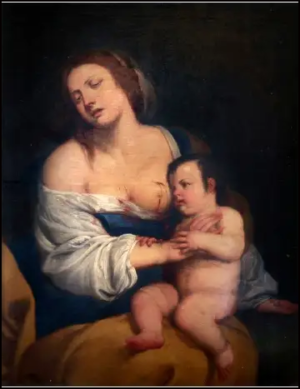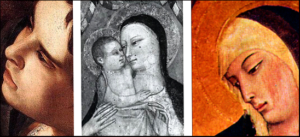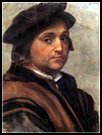
A PARTICULARLY INTIMATE SCENE , OF ANXIETY AND SYMBOLISM.
A DISTRAUGHT YOUNG MOTHER BREAST-FEEDING AN INFANT: A SCENE PARTICULARLY INTIMATE, FULL OF TENSION AND OBSCURE SYMBOLISM.
The Feeding infant, his full bloated tummy attached to two chubby legs is holding on firmly to the young woman’s arm while his dark somnolent eyes peer into the distance with a look of self-satisfaction. The artist shows him at the moment shortly after having been fed. In the process of drawing the milk from the mother’s nipples, his sharp newly emerged teeth, bite the mother’s breast, sufficiently to draw blood. That part of the shift covering her right breast, from which he has already fed, is blood soaked, causing her underlying injuries. The suffering mother’s face is, turned away from the child. Her pallid features and tortured heavy-lidded eyes display the physical signs of amnesia from the loss of blood.
Renaissance scholars, familiar with classical literature were attracted by subjects that were variations on the theme of Hera. The wife of Zeus unwittingly breastfeeding his son Hercules whiles she is asleep. Similar to Artemisia’s canvas the legend depicts him suckling Hera’s breast to the degree that it causes her immense pain. Upon awakening she becomes aware that she not feeding one of her own children and rejects him Jacopo Tintoretto treated the subject, about 1575, in a more elegant fashion in the London, National Gallery’s, The Origin of the Milky Way.
ARTEMISIA APPEARS ON THE EUROPEAN POST WAR ll STAGE. Artemisia’s white drapery handling technique. Left: Mother and Child.
Artemisia’s white drapery handling technique. Left: Mother and Child.
Centre: Lucrezia (1621) Oil on canvas, Palazzo Cattaneo-Adorno, Genoa, Right: Giuditta and her Maidservant (1613-14), Oil on canvas, Pitti Palace, Florence. Detail flipped horizontally.
The painting arrived in a Swedish private collection in the 1960s, a time when research on Artemisia Gentileschi and knowledge of the artist and other Renaissance women artists such as Lavinia Fontana was at an early, more rudimentary state of development. When scholars at the Hague, Netherlands Institute for Art History (Rijksbureau voor Kunsthistorische Documentatie) and the Naples, Museo Capodimonte’s examined the canvas at that time, they tentatively attributed Mother and Child to Artemisia Gentileschi or, alternatively, to her father, Orazio.
The artist has created in the work of art a tension that is almost palpable. It describes an emotion felt, personally, by a very distressed woman, standing in opposition to the child’s evident self-absorbed gratification. The artist’s intention was, likely, an attempt to express her feeling through the painter’s medium, that of her impotence in the face of a society where violence against a woman was the norm; that had the power, and had used it, to treat her with intolerance and disrespect. The courts had inflicted on Agostino Tassi, Artemisia’s bête noire, in 1612, a mild six-month jail sentence for her rape. The style the artist adopted in creating the Mother and Child would correspond to this stressful period of her life.

The baby in our painting might be a symbolic reference to Agostino Tassi. The painter has created the likeness of a Goya-like infant. It’s so unlike her normal treatment of rendering Madonna col Bambino or woman and child themes she practiced both in an earlier period and then took up again towards the end of her career. These cherubs, in contrast, are delightful, crowned with golden locks, attractive, gentle and reach out in a loving manner to a caring mother.
In contrast, for a baby still being suckled, the dark-haired child seems rather mature; he has the head of an adult attached to a child’s body and is blessed with a full complement of luxuriant healthy black hair complete with sideburns. Our swashbuckling infant Hercules is the Baroque era’s answer to the Baby Fist image of a baby boy first posted by its mother on Flickr back in 2007.
The artist has described the infant’s hair with fine and delicate brushstrokes. It is a technique that Artemisia was wont to use when tracing the outline of hair about the ear’s of her female subjects.
In absence of known Tassi portraits the child is a little more convincing than the young male figure traditionally considered his portrait in her 1610 Susannah and the Elder. The partially obscured head, is executed in a run-of-the-mill manner; the artist makes no attempt to endow its creation with any particular importance. In Gentileschi’s 1615 second, Florence version of Judith Decapitating Holofernes, the half severed head of the victim seems to be
based on a possible portrait sketch Agostino Tassi. We know that Cristofano Allori her Florentine associate employed his own 1613 self-portrait, in a canvas of the same format, when he represented the decapitated head in his Judith with the Head of Holofernes.
Orazio Gentileschi’s David and Goliath in the Dublin, National Gallery of Ireland is attributed to 1605-1607 when Artemisia was in her early teens. It reveals Caravaggio’s influence and the ante-litteram three-dimensional hyper-realism fashion slowly creeping into Orazio’s mannerist style. The National Gallery’s conservation laboratory, in the context of a 1970s project to restore the museum’s Old Master collection removed the painting’s the hundred year old layer of darkened classical ‘Gallery varnish’ layer. The intervention revealed the artist’s typical Baroque colour palette.
When, some years later, Mother and Child was subject to similar conservation intervention, a comparison of both canvases revealed a certain affinity in painting styles. Both painters are using similar colour palettes. There is a certain affinity between the cool yellow ochre colour Orazio adopted when painting David’s gilet and the warmer more softly blended ochre colours tone used in the Mother’s cloak.

technical characteristics of Mother and Child
It is noticeable that the artist has prepared the canvas for painting by priming it with a glue and gesso formula, rather than the softer absorbent red clay grounds favoured by the Roman, Neapolitans and Venetian schools. An examination of the naked upper part of the woman’s breast and shoulders reveals a priming that is subject to a regular formed gesso crackleur, a physical characteristics more likely to be found in canvases or timber panels primed during the Florentine Renaissance. That might put the painting in the 1614–1620s when she lived there, married and bore a daughter by a local painter, Pierantonio Stiattesi. However, its style and equally rich colours resemble those used in the Rome, Galleria Spada Madonna and Child, that scholars attribute to 1609.
Artemisia Gentileschi was in London in 1638 probably to assist her ailing father then a court painter for Charles I. Her father’s died in 1639 upon which Artemisia upped bags in 1641 and left for the continent and Naples. Many prominent painters, Rubens included were going in the same direction. the English Civil War, Charles I‘s mishaps resurgent iconoclasm, dismemberment and dispersal of art collections, always a bad business for painters and the cold winds of a new and unfriendly cultural atmosphere encouraged the exodus.
The Caravaggio influence was on the ebb being replaced by the first intimations of neo-classicism was arriving via Annibale Carracci and painters of the Venetian school represented by Luca Giordano. It is difficult to in identify canvases that can specifically be attributed to Artemisia’s late Neapolitan period. The artist may have caught on the wing the new manner of painting that, eventually, evolved into the Rococo. They are the creations of a more tranquil and relaxed person. Gone is the edginess and the in-your-face style she displayed in Judith Decapitating Holofernes and the present, Mother and Child.
And thus did some of the greats of Baroque, and the Baroque itself, die: Caravaggio in 1610, Artemisia, 1656 and Rembrandt in 1669. None of the three had happy and tranquil resting places. The self-destructive and star-crossed Caravaggio died, apparently in Porto Ercole in Tuscany and buried expeditiously in the obscure and now no-longer existing San Sebastiano cemetery nearby.
An equally casual and matter-of-fact entombment awaited Rembrandt’s remains when he died His relatives, lacking adequate means to purchase a private grave and accompanying tombstone buried him anonymously in the Westerkerk. His remains, like those of Titus, his son who had died recently and of Saskia who had preceded him a quarter of a century before were all consigned to mass graves. Seven years previously, and still in need of funds, he had sold Saskia’s tomb in the Oude Kerk.
Artemisia reaches her Apotheosis and leaves the Public Stage
Artemisia disappeared from the Naples art scene during the plague epidemic of 1656-58. throughout the successive social upheaval and devastation to the local economy an entire generation of Neapolitan artists together with local records and those relating to her demise, disappeared. She was, it appears, buried in the church of San Giovanni dei Fiorentini. According to earlier chroniclers, her funeral was a dignified occasion with a recognition and testimonies from the great and the good to her important contributions in the development of Florentine art.
The church, in 1845, was modernised in the neoclassical style, typical of the period, but in the process, the tombstones embedded in the floor of the church were dislodged and all records lost as to the names of their occupants, including those of Artemisia. Unfortunately Artemisia’s remains suffered further indignity caused by the World War ll bombing of Naples. The church was demolished in 1950s with the dubious justification that it had suffered severe collateral war damage. Subsequent enquiries proved this to be incorrect. What remains of the church and Artemisia that were still in existence were, it would seem, regarded by the local authorities as an obstacle to the execution of the kind of urban development that was typical of the time.
EXTERNAL LINKS
Micone and Pero
https://it.wikipedia.org/wiki/File:Affresco_romano_-_Pompei_-_Micon_e_Pero.jpg
_________________________________________________________
NOTES AND EPHEMERA
The Pelican as an iconographic religious symbolism
«Questi è colui che giacque sopra ‘l petto
del nostro pellicano, e questi fue di su la croce al grande officio eletto». la divina commedia, (Paradiso, XXV, 112-114).

The images attributed to Agostino Tassi, Wikipedia page leads to the site: https://virginiaburges.files.wordpress.com/2016/08/agostino-tassi-self-portrait.jpg?w=676. It seems to be painted onto a fresco-like support. Enquiries as to the location of the portrait, Palazzo Pamphilj, or elsewhere in Rome, and sources that identify it as a portrait or self portrait of the painter have failed to evoke a response or to confirm that scholars accept it as such.
Save Your Old Paintings!
Don't throw away that bedraggled old painting. Get a free professional evaluation and learn how to preserve your artistic heritage for future generations.
Get a Free Evaluation